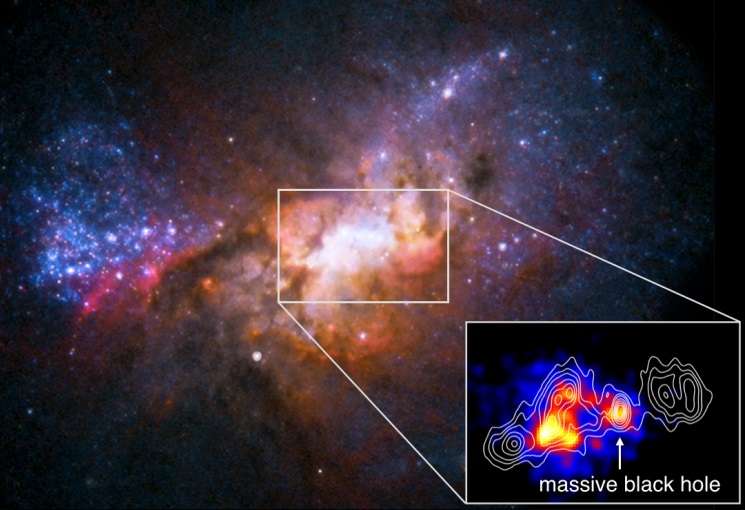October 19, 2016 report
X-ray point source discovered at the center of a distant dwarf galaxy Henize 2-10

(Phys.org)—NASA's Chandra X-ray Observatory has helped astronomers to uncover a previously unidentified X-ray point source at the massive black hole in the center of a distant compact starburst galaxy known as Henize 2-10. The findings are available in a paper published Oct. 5 on the arXiv pre-print server.
Located some 34 million light years away in the constellation of Pyxis, Henize 2-10 is the first dwarf galaxy found to have a supermassive black hole at its center. With a mass of less than 10 billion solar masses, it is a compact starburst galaxy hosting numerous young "super star clusters" and a candidate low-luminosity active galactic nucleus (AGN).
The presence of an AGN in Henize 2-10 offers an excellent opportunity to study massive black hole accretion and star formation. This is due to the fact that active nuclei in dwarf galaxies undergoing a burst of star formation reveal essential astronomical processes. They could offer crucial insights on the interplay between a massive black hole and the stars of the galaxy in which it forms.
Last year, in February 2015, a team of astronomers led by Amy Reines of the University of Michigan conducted new Chandra observations of Henize 2-10 complementary to those performed in 2001. The new data obtained by the researchers allowed them to uncover the presence of a previously unidentified X-ray point source, spatially coincident with the known nuclear radio source in this dwarf galaxy.
"Chandra clearly resolved the nuclear emission in Henize 2-10 and revealed the varying hard X-ray source to be due to a nearby X-ray binary, where a black hole, or a neutron star, eats material from a nearby typical star," Mark Reynolds of the University of Michigan, co-author of the paper, told Phys.org.
The fact that the new source is so bright allows the researchers to assume that the X-ray binary contains a "hungry" stellar-mass black hole that is eating very rapidly. They added that only very few X-ray binaries in our galaxy consume as much material as this source.
However, the scientists still need to determine the cause of the variability observed from that source.
"For example, it might be due to changes in the structure of the material it is eating. Another idea is that the variability could be driven by the time it takes the nearby star to orbit the stellar-mass black hole," Reynolds said.
This black hole in Henize 2-10 is potentially of great importance for astronomers, as it is the best-known example of a supermassive black hole in a dwarf galaxy. It is believed that early in the universe, relatively low-mass black holes grew in the initial galaxies that were small and gas-rich, such as Henize 2-10.
"Thus, this provides critical insight into the early stages of galaxy and black hole evolution. Our new observations have shed light on the X-rays emitted from the nucleus of Henize 2-10. The massive black hole in this galaxy appears to be eating material in a similar manner to, for example, the supermassive black hole at the center of our Galaxy," Reynolds concluded.
The team plans to focus their future observations of Henize 2-10 on studying its supermassive black hole emission by observing when the X-ray binary is eating relatively slowly and is not bright. This could provide new information on the relationship between how this supermassive black hole eats material and the "burps" it gives off, and to determine how this influences star formation in this galaxy.
More information: Deep Chandra Observations of the Compact Starburst Galaxy Henize 2-10: X-rays from the Massive Black Hole, arXiv:1610.01598 [astro-ph.HE] arxiv.org/abs/1610.01598
Abstract
We present follow-up X-ray observations of the candidate massive black hole (BH) in the nucleus of the low-mass, compact starburst galaxy Henize 2-10. Using new high-resolution observations from the Chandra X-ray Observatory totaling 200 ks in duration, as well as archival Chandra observations from 2001, we demonstrate the presence of a previously unidentified X-ray point source that is spatially coincident with the known nuclear radio source in Henize 2-10 (i.e., the massive BH). We show that the hard X-ray emission previously identified in the 2001 observation is dominated by a source that is distinct from the nucleus, with the properties expected for a high-mass X-ray binary. The X-ray luminosity of the nuclear source suggests the massive BH is radiating significantly below its Eddington limit (~10^-6 L_Edd), and the soft spectrum resembles other weakly accreting massive BHs including Sagittarius A*. Analysis of the X-ray light curve of the nucleus reveals the tentative detection of a ~9-hour periodicity, although additional observations are required to confirm this result. Our study highlights the need for sensitive high-resolution X-ray observations to probe low-level accretion, which is the dominant mode of BH activity throughout the Universe.
© 2016 Phys.org





















